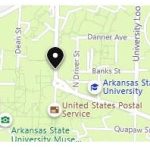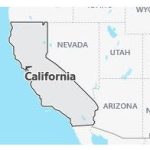
Historically interesting places
Three Mile Island Nuclear Power Plant near Harrisburg
The Three Mile Island Nuclear Power Plant (exactly: Three Mile Island Nuclear Generating Station) is located on the island of the same name in the Susquehanna River near Harrisburg. The city of Harrisburg is the capital of the state and has around 50,000 residents – around 650,000 in the metropolitan region.
The nuclear power plant near Harrisburg has become known worldwide due to a serious accident. On March 28, 1979, a partial (partial) meltdown occurred in the reactor – largely due to operating errors by the personnel. As a result of the accident, around 200,000 people had to be evacuated and there was a long-term risk of an oxyhydrogen gas explosion with serious consequences. After the accident, gas had to be released from the reactor to reduce the pressure in the reactor. An activity of approx. 1.7 terabecquerel – especially Krypton 85 (Kr 85) – came into the environment. 1 terabecquerel is equal to 10 12Becquerel (Bq). Krypton 85 has a rounded up half-life of 10.76 years. The maintenance work on the reactor took over 12 years. Since then, no new nuclear power plant has been put into operation in the United States.
Gettysburg National Military Park
The Gettysburg National Military Park is the largest battle memorial. It deals with the Battle of Gettysburg, fought in the American Civil War in 1863. This is arguably the best researched battle of war. In Gettysburg National Military Park you can see over 1000 testimonials of the battle, as well as the battlefield itself. The main attractions on the battlefield include the Little Round Top, Cemetery Ridge, Devil’s Den and the Eternal Light Peace Memorial.
The Gettysburg National Military Park Museum and Visitor Center is a good starting point for the tour.
| Contact | 1195 Baltimore Pike Gettysburg, Pennsylvania 17325 www.nps.gov/gett/index.htm |
Steamtown National Historic Site at Scranton
Steamtown National Historic Site is a railroad museum in central Scranton. It is built around a still functioning train hub and a locomotive hall, on what was once Pennsylvania’s most important transportation route, the Delaware, Lackawanna and Western Railroad. It opened in 1995 and the basis of the exhibition is the steam locomotive collection of the millionaire F. Nelson Blount, who started the project.
There is a technology museum and a historical museum to visit and you have the opportunity to take a historic steam train on the “Scranton Limited Short Train Excursion”.
| Contact | 150 South Washington Ave Scranton, Pennsylvania 18503 www.nps.gov/stea/index.htm |
Independence National Historic Park in Philadelphia
The Independence National Historic Park is located in downtown Philadelphia and includes some of the most important historic buildings known to be associated with American independence. These buildings include:
- Carpenters Hall
The former headquarters of the Carpenters’ Guild, built in 1770. - Congress Hall
The Congress Hall was the seat of the United States government from 1790 to 1800. - First Bank of the United States and Second Bank of the United States
Theater performances and art exhibitions are held here today. - Graff House
Thomas Jefferson lived in Graff House while writing the American Declaration of Independence. - Independence Hall
Independence Hall is the main attraction of the Independence National Historic Park. The Declaration of Independence was accepted here and the Independence Hall is considered the birthplace of today’s USA. - Liberty Bell Pavilion
Here is the Liberty Bell, which was beaten to accept the Declaration of Independence. It used to be in Independece Hall. - New Hall and Pemberton House
The former War Department. Nowadays the Marine Corps Museum and the Army Navy Museum are located here. - Old City Hall
The Old City Hall was the city hall of Philadelphia when the city was still the capital of the USA.
| Contact | 143 S. Third Street Philadelphia, Pennsylvania 19106 www.nps.gov/inde/index.htm |
Valley Forge National Historic Park
The Valley Forge National Historic Park, near the town of Valley Forge, is where the American continental army spent the winter of 1777/1778 during the Revolutionary War.
Today historical buildings, the replica of the army winter camp, as well as a museum with exhibits from the period and an overview of the history of the War of Independence can be visited there.
| Contact | 1400 North Outer Line Drive King of Prussia, Pennsylvania 19406 www.nps.gov/vafo/index.htm |
Edgar Allan Poe National History Site near Philadelphia
The Edgar Allan Poe National History Site near the city of Piladelphia serves as a shelter for the house where the famous author lived from 1843 to 1844. It is the only surviving house in which Poe lived. This house was built in 1842 and has been under protection status since 1966. The rooms in the house have not been retrofitted with furniture from Poe’s time, except for the reading room, which refers to the Eassay “The Philosophy of Furniture” by Poe. In this reading room, visitors will find all of Edgar Allan Poe’s works and additional material.
| Contact | 20 North 8th Street Philadelphia, Pennsylvania 19107 www.nps.gov/edal/index.htm |
Special buildings and structures
Liberty Bell
The Liberty Bell is the liberty bell that was rung on the occasion of the proclamation of the United States Declaration of Independence on July 8, 1776. Ironically, the Liberty Bell was cast in London in 1752. “Proclaim Liberty throughout all the land unto all the residents thereof” is emblazoned on the bell. The bell is riddled with a big crack these days, which makes it unsuitable. Nowadays, the bell is no longer in Independence Hall, but opposite it in the Liberty Bell Pavilion and, together with the Independence Hall complex, is a UNESCO World Heritage Site.
Pennsylvania State Capitol in Harrisburg
The Pennsylvania State Capitol is located in the city of Harrisburg and is the seat of the government of the State of Pennsylvania. The Pennsylvania State Capitol was built from 1902 to 1906 in the Beaux-Arts style, which is based on the Renaissance. The Pennsylvania State Capitol was modeled on St. Peter’s in Rome. However, this building is the third state capitol in the city of Harrisburg. The first was destroyed by fire in 1897 and the second was never completed due to financial difficulties. The Pennsylvania State Capitol has a height of 83 m and on the top of the rotunda is a statue that is personified by the Commonwealth of Pennsylvania. The Pennsylvania State Capitol is nicknamed “Palace of Arts” because of the many sculptures,
| Contact | North 3rd Street Harrisburg, Pennsylvania 17120 www.pacapitol.com |
Independence Hall in Philadelphia
Independence Hall in the city of Philadelphia is considered the birthplace of today’s USA. Independence from England was declared here in 1776 and in 1787 the Philadelphia Convention, a constitutional assembly consisting of 55 delegates, met here, which signed the new constitution on September 17, 1787 and handed it over to the Congress in Washington for ratification. The building, completed in 1753, originally served as the Pennsylvania State House of the (colonial) government of Pennsylvania. The construction of Independence Hall began in 1732. The above-mentioned Liberty Bell was also in the building from 1753 to 1776. Independence Hall is prominently immortalized on the back of the 100 dollar bill.
| Contact | 500 Chestnut Street Philadelphia, Pennsylvania 19106 www.nps.gov/inde/index.htm |
Philadelphia City Hall
The Philadelphia City Hall is the city hall of the city of Philadelphia, which was built between 1871 and 1901. The Philadelphia City Hall is built in Victorian style. Outstanding is the 167 m high clock tower, which is the second tallest brick building in the world after the Mole Antonelliana in Turin. There is a bronze statue of William Penn on the top of the clock tower. The Philadelphia City Hall is centrally located in the historic city center. For visitors there are also tours through the 700 rooms, past over 250 reliefs and sculptures.
| Contact | 1 Penn Square Philadelphia, Pennsylvania 19107 www.phila.gov/virtualch |
Kinzua Bridge
The Kinzua Bridge is or was a scaffold pillar viaduct in northern Pennsylvania and spanned Kinzua Creek. The bridge was 92 m high and 625 m long. The Kinzua Bridge was built from 1881 to 1882. In 1900 the bridge was strengthened due to the higher train weights. From 2002 the train traffic was stopped due to the poor condition of the bridge. Finally, in 2003, a tornado destroyed 11 of a total of 20 pillars and partially caused the bridge to collapse. The Kinzua Bridge State Park is also located here.
Comcast Center in Philadelphia
The Comcast Center in the city of Philadelphia is the tallest building in the state of Pennsylvania at 297 m. The skyscraper was built from 2005 to 2008. However, the Comcast Center is more than just a skyscraper. There are also art installations here. The Comcast Experience, a huge LED screen with an area of approx. 190 m², is significant.
| Contact | 1701 John F Kennedy Blvd Philadelphia, Pennsylvania 19103 |
1UpTravel.com – Maps of Pennsylvania
Browse a collection of state, city, national park, monument, and historical maps of this US state. Includes maps of Philadelphia and Gettysburg National Military Park.
Website: http://www.1uptravel.com/worldmaps/pennsylvania.html
Pennsylvania – National Geographic Map Machine
Read a little bit about the state’s history and take a look at the shaded-relief map. Includes an overview of industry and agriculture.
Website: http://www.nationalgeographic.com/maps/atlas/usstates/spenns
Pennsylvania – University of Texas Library
Delve into these state and city maps, both current and historical. Also find maps of national battlefields, military parks and monuments.
Website: http://www.lib.utexas.edu/Libs/PCL/Map_collection/pennsylvan
Pennsylvania – US Census Bureau Map
Divided into counties, this clickable map presents data such as demographic information and an economic census.
Website: http://www.census.gov/datamap/www/42.html







